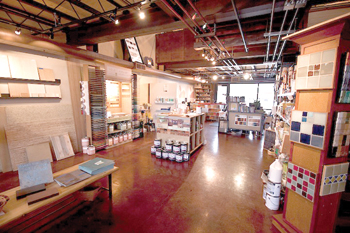Refuge Building: Saving Green by Going Green
Alexa Calio, owner of Refuge Building, knows consumers are concerned with saving money. While people are convinced of the health benefits of using green products, they hesitate because they’re afraid it’s unaffordable. She wants to educate consumers about how going green can keep their wallets healthy, too.
Calio purchased the company in 2010, and brought several new products to the store, including Fireclay Tile, RAIS Stoves, and YOLO Colorhouse VOC-free paints.
The cost issue is one she continues to hear.
“It’s a common misconception that sustainable products are much more expensive than traditional products of the same quality,” she says. “But often the green materials are more durable and less expensive.”
To illustrate this, she has product-by-product numbers that compare costs of paint, flooring and countertops for a 2,500-square-foot home. The Comparison Chart is available on Refuge Building’s website.
The bottom line? The sustainable materials cost $2,100 less than similar conventional products. While consumers can save on the purchase, Calio believes the real value is in the durability.
“Many consumers don’t factor in durability when making a purchase, which is critical in terms of understanding a product’s true cost and also determining if it is truly sustainable,” she says on her blog. “If a particular product needs to be replaced in two years or even five years, it may end up costing more in the long run via replacement costs.”
As an example, Paperstone countertops come with a 15-year warranty, and the bamboo flooring has a 25-year warranty. American Clay Plaster, which comes in a wide variety of colors, lasts the life of the building.
“Use of products like these also translates to added value in remodels and resales,” she says. The goal is to be aesthetically pleasing and also environmentally sound.
The concern around the use of traditional products is growing.
New homes are built to be energy-efficient, which creates tightly sealed buildings.
“It’s common to have less than one air exchange every hour,” Calio says, “so it becomes very important to care about the off-gassing of products that are put into the home.”
Research has shown that the air quality in buildings with certain high-VOC (Volatile Organic Compounds) products can be worse than the air outdoors. Refuge Building carries low VOC materials in such commonly used items as paints, stains, finishes and sheet goods.
Calio wants the consumer to have choices, and she strives to offer a selection that is diverse.
“You don’t walk into Refuge and see the same things you see everywhere else,” Calio says. “You see some really unique products, and there is a fun story behind the products.”
Case in point, the fly ash and glass concrete. Created by Jon Cross, an innovative fabricator located in Bozeman, the product has been used for countertops and furniture since 2000. In 2007, the Missoula Credit Union became the first building in the U.S. to use fly ash and glass concrete for the foundation, slab, in precast elements and structural beams.
The Credit Union called on residents to collect their empty glass containers to meet the amount required – an estimated 300-400 tons of pulverized glass for the concrete mix. The fly ash is a by-product created when coal is burned for electricity.
“You’re basically taking a waste product and turning it into something unique that can be used in floors, countertops, tiles, showers and more.” Calio says. “And it’s a 100% made in Montana.”
Sources include fly ash from a Billings power plant and glass beer and wine bottles recovered from the Yellowstone River. The product is manufactured in Bozeman. It’s versatile, and passes the durability test.
To help consumers decide how sustainable materials can fit into their plans, Calio offers free design and consulting services. “Bring your blueprints and we can give you a project bid,” she says.
The selections constantly evolve as innovations in green building materials continue. “At Refuge,” Calio says, “we want to offer better choices for personal health and the health of the environment.”
And if going green saves green, Refuge Building should be the first stop for construction and remodeling projects.
Lynn Kinnaman is the author of several books, numerous magazine and newspaper articles, and blogs. She is the owner of Works by Design, a website design company, and helps businesses and individuals communicate their message through writing, marketing and an effective online presence. She continues to write for magazines and has two books coming out in early 2012. She can be contacted at Lynn@LynnKinnaman.com/.